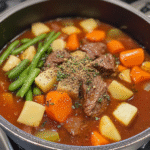If there’s one thing that makes a meal truly comforting, it’s the warmth of a hearty beef stew — and the key to making that stew sing is a killer beef stew seasoning recipe! Whether you’re a busy mom trying to whip up something filling for the family or a professional looking for an easy and delicious dinner after a long day, this simple yet flavorful seasoning is here to save your evening.
Let’s face it, life is busy. We all need meals that come together quickly, taste amazing, and don’t require a million ingredients. And that’s exactly what this beef stew seasoning does — it’s easy to make, full of flavor, and perfectly complements your beef stew without any fuss.
Why You’ll Love This Beef Stew Seasoning Recipe
Have you ever prepared beef stew and thought it needed a little extra something to make it perfect? Maybe it was a little too bland, or just didn’t have that comforting depth of flavor. This seasoning is the magic that transforms your stew into a dish your family will ask for again and again. It’s a perfect blend of savory, earthy spices that brings out the best in your beef, veggies, and broth.
The key to this dish is building layers of flavor that come together beautifully.
From the garlic to the thyme and bay leaves, every bite of this stew will have your taste buds dancing. Plus, this easy beef stew seasoning recipe is customizable, so you can tweak it to match your family’s tastes. Let’s dive into why this seasoning will become your go-to, and how it helps you create a dish that’s not only delicious but also full of health benefits!
Practical Tips / Cooking Tips
Before we jump into the ingredients and instructions, let’s talk about a few practical tips. These small tweaks can make all the difference!
- Mix it up: Don’t hesitate to add a little extra seasoning if you like it bold! A dash of paprika or cayenne can give it a nice kick without overpowering the dish.
- Herb swap: Don’t have thyme or bay leaves on hand? No problem! Try swapping in rosemary or oregano — they both add a unique flavor, and we all know how flexible stew recipes can be.
- One-pot wonder: Beef stew is the ultimate easy meal, all in one pot. Just toss everything in and let it cook while you handle other things.
Nutritional Value / Health Benefits
Not only does this beef stew seasoning recipe bring loads of flavor, but it also contributes to your health in some surprising ways! Here’s a quick look at some of the benefits packed in this simple blend:
| Nutrient | Amount | % Daily Value |
|---|---|---|
| Calories | 15 | 1% |
| Protein | 1g | 2% |
| Fiber | 1g | 4% |
| Iron | 1mg | 5% |
- Iron Boost: This seasoning blend includes savory ingredients like garlic and thyme, both of which help with iron absorption, essential for boosting energy.
- Antioxidants: Garlic and bay leaves are rich in antioxidants, helping fight inflammation and keep your heart healthy.
- Flavor without guilt: This seasoning gives you big flavor without adding any extra fat or sugar, making it perfect for a healthier, wholesome meal.
Recipe Overview
Making your own seasoning for beef stew isn’t just about adding flavor — it’s about making your stew feel like home. And trust me, once you get this seasoning down, you’ll wonder why you ever bought pre-made packets.
Here’s a quick summary of the key steps:
- Combine all of the spices in a bowl — no cooking required!
- Add your seasoning blend to your beef stew as it simmers away.
- Taste it (yes, you can already smell how amazing it’s going to be!) and adjust the seasoning if needed.
You’ll have a warm, comforting beef stew with the most amazing seasoning, all made with just a few simple ingredients. This recipe became my go-to when I needed something quick and hearty after work. The kids loved it, and it was always such a treat to hear them ask, “What’s that delicious smell?”
Ingredients
Here’s what you’ll need to make this easy beef stew seasoning recipe:
| Ingredient | Quantity | Substitute Option |
|---|---|---|
| Onion Powder | 2 tbsp | Shallot Powder |
| Garlic Powder | 1 tbsp | Fresh Garlic (minced) |
| Dried Thyme | 1 tbsp | Dried Rosemary |
| Dried Bay Leaves | 2 leaves | Ground Bay Leaf |
| Salt | 1 tsp | Kosher Salt |
| Black Pepper | 1 tsp | White Pepper |
| Paprika | 1 tsp | Smoked Paprika |
This seasoning blend is versatile, so feel free to add more or less based on your personal taste. For an extra kick, add a dash of cayenne pepper. If you want to make it a bit milder for the kids, cut back on the pepper.

Instructions
- Combine the spices: In a small bowl, mix the onion powder, garlic powder, thyme, bay leaves, salt, black pepper, and paprika. This blend is your magic ingredient that will make your stew taste like it’s been simmering all day.
- Add to your stew: Once your beef stew is simmering, stir in about 2 tablespoons of this seasoning. Let everything cook together, and your house will soon be filled with the comforting smell of a homemade meal.
- Adjust the seasoning: After cooking, taste your stew. Need more salt or a bit more pepper? Feel free to adjust the seasoning to match your personal taste.
FAQs
Can I substitute any of the ingredients in this seasoning recipe?
Yes, absolutely! If you don’t have dried thyme, rosemary is a great substitute. If you’re out of onion powder, you can use fresh onions — just sauté them with the beef before adding the broth.
How do I store leftovers of the beef stew?
You can keep any leftover beef stew in an airtight container in the fridge for up to 3 days.. You can also freeze it for up to 3 months — perfect for those busy days when you don’t want to cook.
Let’s Wrap It Up!
This easy beef stew seasoning recipe is all about bringing flavor to your family’s dinner table without all the stress. With just a handful of ingredients, you can transform your beef stew into a mouthwatering dish everyone will enjoy. Plus, with this seasoning recipe, you’re in control — no more store-bought packets!
So, what are you waiting for? Get cooking, and don’t forget to share this recipe with your friends or explore more amazing dishes on the blog. Happy cooking, and I hope your kitchen smells as amazing as mine does every time I make this beef stew!
Enjoy your cozy meal, and remember, cooking is all about having fun and experimenting with flavors!
Print
The Best Homemade Beef Stew Seasoning Recipe
- Total Time: 5 minutes
- Yield: about 6-8 servings
Description
This homemade beef stew seasoning recipe is your ticket to a rich, flavorful stew without the hassle. Simple to make with ingredients you probably already have, this seasoning blend will elevate your beef stew, making it the perfect dish for busy evenings or family gatherings.
Ingredients
- Onion Powder: 2 tbsp Shallot Powder
- Garlic Powder: 1 tbsp
- Dried Thyme: 1 tbsp
- Dried Bay Leaves: 2 leaves
- Salt: 1 tsp
- Black Pepper: 1 tsp
- Paprika: 1 tsp
Instructions
- Combine the spices: In a small bowl, mix together the onion powder, garlic powder, dried thyme, bay leaves, salt, black pepper, and paprika. This blend is your key to a flavorful beef stew.
- Add to your stew: Once your beef stew is simmering, add about 2 tablespoons of the seasoning mix. Stir well and let the flavors meld together as the stew continues to cook.
- Taste and adjust: After cooking, taste your stew. Does it need a little more salt or pepper? Adjust to your taste.
Notes
- This seasoning can be made in bulk and stored in an airtight container for later use.
- Feel free to experiment with additional spices like cayenne pepper if you prefer a bit more heat in your stew.
- This seasoning is versatile and can also be used in other hearty soups or stews.
- Prep Time: 5 minutes
- Category: seasoning
- Method: Mixing recipes
- Cuisine: American
Nutrition
- Serving Size: 1 tbsp
- Calories: 15 g
- Sugar: 0
- Sodium: 240 mg
- Fat: 0
- Saturated Fat: 0
- Unsaturated Fat: 0
- Trans Fat: 0







